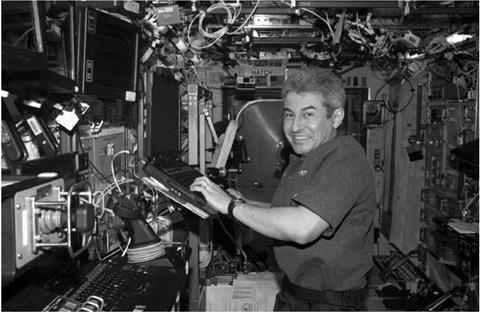EXPEDITION-13
With the departure of Soyuz TMA-7, the Expedition-13 crew began their 6-month occupation of ISS. If all went well the third member of this crew would be launched on STS-121, on April 1, 2006. German astronaut Thomas Reiter would become the first Expedition crew member that was neither American nor Russian. His arrival on ISS would raise the Expedition crew to three for the first time since May 2003, when the crew was reduced to conserve supplies in the wake of the loss of STS-107, Columbia. Reiter, an ESA astronaut who had spent a tour on Mir, was a commercial passenger flying under contract to the Russians.
|
Figure 68. Expedition-13: Brazilian spaceflight participant Marcos Pontes works in Destiny. He rode to the station in Soyuz TMA-8 with the Expedition-13 crew and returned to Earth with the Expedition-12 crew. |
Vinogradov and Williams had a light workload during their first weekend alone on the station before picking up the pace on the following Monday. On April 11, they had spent 3.5 hours performing maintenance on the station’s toilet. The following day, April 12, Russian President Vladimir Putin spoke to the crew from the Kremlin in Moscow, to mark the 45th anniversary of the first human spaceflight, made by Yuri Gagarin, in 1961. Vinogradov jokingly invited his President to visit the station. The same date was the 25th anniversary of the first Shuttle flight in 1981. The crew continued the task of loading rubbish in to Progress M-55, and completed the routine emergency evacuation drill early in their occupation.
Their third week on the station was filled with Williams performing American experiments and both men performing the first of three sessions on the Renal Stone Experiment. They also spent time preparing for the arrival of Progress M-56, including Vinogradov practising with the TORU system. On July 18, Korolev transferred propellant from Progress M-55 to Zvezda’s tanks. The following day a planned reboost of the station’s orbit was cancelled when telemetry showed that one of the sunshades on Zvezda’s thrusters had not opened to its full extent. The malfunction was detected by the station’s software which then inhibited the ignition of the thrusters. The firing had been designed to test-fire two thrusters that had not been used since Zvezda docked to ISS, in July 2000. Engineers at Korolev began reviewing the problem and discovered that the opening of the sunshade had been impeded by an ATV antenna installed in September 2004.











